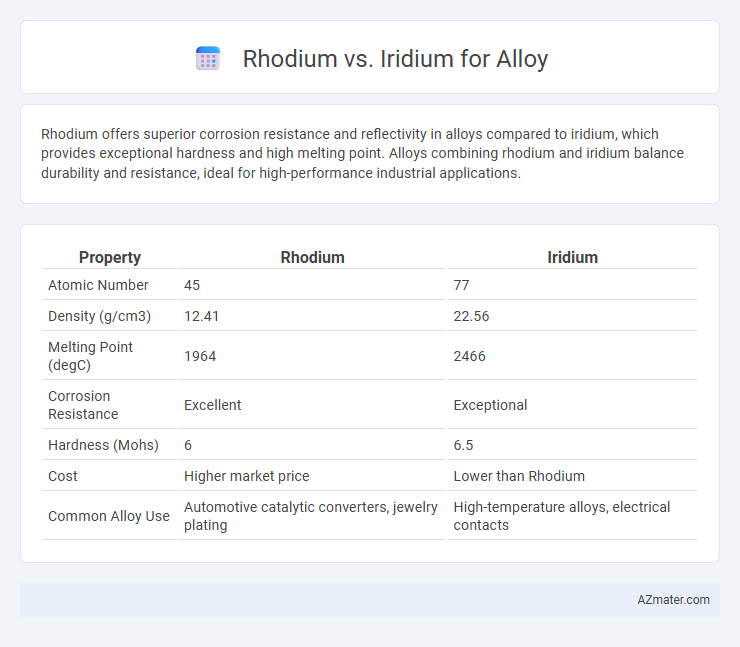Rhodium offers superior corrosion resistance and reflectivity in alloys compared to iridium, which provides exceptional hardness and high melting point. Alloys combining rhodium and iridium balance durability and resistance, ideal for high-performance industrial applications.
Table of Comparison
| Property | Rhodium | Iridium |
|---|---|---|
| Atomic Number | 45 | 77 |
| Density (g/cm3) | 12.41 | 22.56 |
| Melting Point (degC) | 1964 | 2466 |
| Corrosion Resistance | Excellent | Exceptional |
| Hardness (Mohs) | 6 | 6.5 |
| Cost | Higher market price | Lower than Rhodium |
| Common Alloy Use | Automotive catalytic converters, jewelry plating | High-temperature alloys, electrical contacts |
Introduction to Rhodium and Iridium
Rhodium and iridium, both members of the platinum group metals, exhibit exceptional corrosion resistance and high melting points, making them valuable for alloy applications. Rhodium is prized for its brilliant reflectivity and hardness, commonly enhancing jewelry and catalytic converters. Iridium, known for its remarkable durability and resistance to oxidation, serves critical roles in aerospace and electrical contacts.
Chemical and Physical Properties Comparison
Rhodium and iridium are both members of the platinum group metals, characterized by exceptional corrosion resistance and high melting points, with rhodium melting at 1964degC and iridium at 2446degC. Rhodium exhibits a higher reflectance and superior catalytic properties, making it ideal for applications requiring chemical stability and luster, while iridium offers greater hardness, density (22.56 g/cm3 versus rhodium's 12.41 g/cm3), and resistance to oxidation at extreme temperatures. Their chemical inertness and physical durability render rhodium optimal for automotive catalytic converters and jewelry, whereas iridium's robustness suits it for high-temperature crucibles and electrical contacts in harsh environments.
Abundance and Sourcing
Rhodium and iridium, both members of the platinum group metals, differ significantly in abundance and sourcing, impacting their availability for alloy production. Rhodium is rarer than iridium, with annual global production around 30 tons compared to iridium's approximately 7 tons, predominantly extracted as a byproduct of platinum and nickel mining in South Africa and Russia. The scarcity of rhodium and its concentration in limited geographic regions contribute to higher prices and supply volatility, whereas iridium's relatively steadier sourcing stems from more widespread deposits and stable mining outputs.
Alloying Behavior and Compatibility
Rhodium exhibits excellent corrosion resistance and enhances hardness when alloyed with platinum or palladium, demonstrating strong compatibility in high-temperature and chemical-resistant applications. Iridium offers exceptional density and oxidation resistance, improving alloy stability and durability, especially in aerospace and industrial components. Both metals show high melting points, but rhodium's superior ductility allows for better workability in alloy formation compared to the more brittle iridium.
Mechanical Strength and Durability
Rhodium alloys exhibit superior mechanical strength and exceptional hardness, making them highly resistant to wear and deformation under stress. Iridium alloys, known for their outstanding corrosion resistance and high melting point, provide remarkable durability in extreme environments and maintain structural integrity over long periods. Compared to rhodium, iridium alloys offer enhanced longevity and resistance to oxidation, making them ideal for applications requiring both mechanical strength and prolonged durability.
Corrosion and Oxidation Resistance
Rhodium exhibits superior corrosion resistance compared to iridium, making it an excellent choice for alloys exposed to harsh chemical environments. Iridium, however, demonstrates exceptional oxidation resistance at high temperatures, retaining structural integrity under extreme conditions. Alloys combining rhodium and iridium leverage the corrosion resistance of rhodium with the oxidation stability of iridium for enhanced durability.
Industrial and Commercial Applications
Rhodium and iridium are both valuable platinum-group metals widely used in industrial and commercial alloy applications due to their exceptional corrosion resistance and high melting points. Rhodium alloys are favored in automotive catalytic converters and electrical contacts for their excellent oxidation resistance and reflectivity, while iridium alloys are preferred in high-temperature aerospace components and spark plugs due to their superior hardness and durability. The choice between rhodium and iridium alloys depends on the specific thermal and mechanical requirements of the application, with rhodium excelling in catalytic efficiency and iridium providing strength under extreme conditions.
Cost and Market Trends
Rhodium commands a significantly higher price than iridium, driven by its critical role in catalytic converters and limited supply, with spot prices often exceeding $10,000 per ounce compared to iridium's $5,000-$6,000 range. Market trends indicate growing demand for rhodium in automotive and industrial applications, causing price volatility and strong investment interest, while iridium's use in electrical contacts and spark plugs maintains steady but lower demand. Alloy manufacturers prioritize rhodium despite cost pressures due to its superior corrosion resistance and catalytic efficiency, whereas iridium alloys offer cost-effective alternatives for specialized high-temperature uses.
Environmental Impact and Sustainability
Rhodium and iridium, both members of the platinum group metals, are valued in alloys for their corrosion resistance and high melting points, but rhodium's rarity leads to higher environmental extraction costs compared to iridium. Iridium's relative abundance and lower mining impact contribute to more sustainable alloy production, with recycling of iridium-containing alloys further reducing ecological footprints. Life cycle assessments reveal that maximizing iridium use in catalytic and industrial alloys promotes sustainability by minimizing energy-intensive mining and material waste.
Choosing the Right Alloy: Rhodium or Iridium
Rhodium alloys offer exceptional hardness and high reflectivity, making them ideal for jewelry plating and catalytic converters, whereas iridium alloys excel in corrosion resistance and high-temperature stability, suitable for aerospace and medical applications. Selecting the right alloy depends on the specific environmental demands and durability requirements, with rhodium preferred for decorative finishes and iridium favored in extreme conditions. Cost considerations also influence choice, as rhodium is generally more expensive but delivers superior brightness, while iridium provides long-term resilience.

Infographic: Rhodium vs Iridium for Alloy
 azmater.com
azmater.com